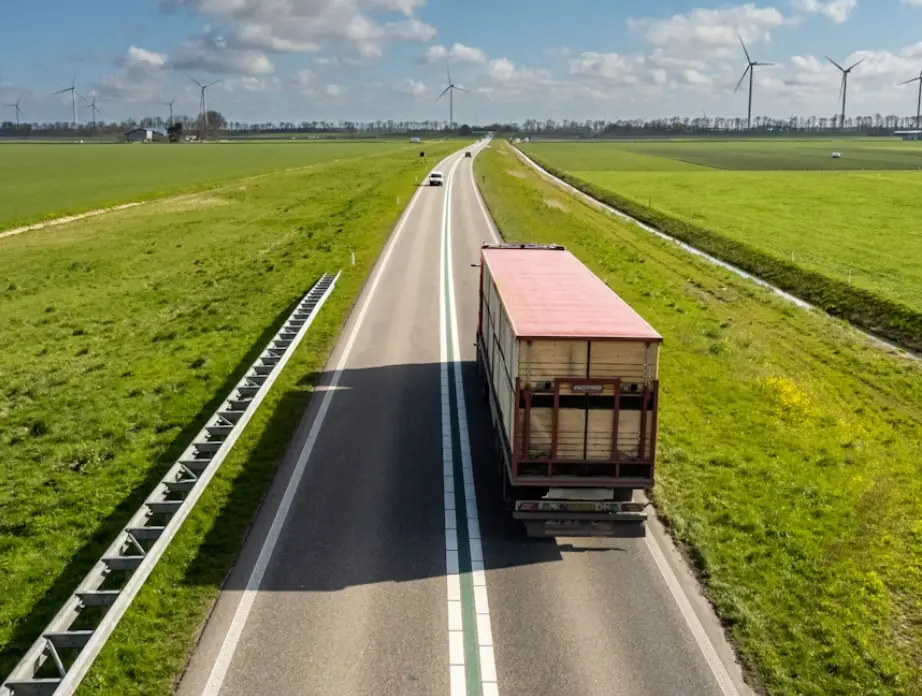Modern supply chains are more complex than ever, with goods moving through various stages, from factories to customers. The old way of managing logistics with separate systems and manual processes can't keep up with the demands of today's fast-paced business world.
That's where logistics visibility platforms come in. These innovative solutions are changing the game by giving organizations the complete visibility they need to tackle these challenges head-on.
Think of these advanced platforms as the command center for your supply chain operations. They connect different data sources and turn raw information into valuable insights, allowing you to see every part of your logistics network clearly—whether it's inventory levels, shipment status, or yard operations.
With the growing importance of supply chain transparency, logistics visibility platforms have become crucial in digital transformation efforts. Companies in all industries understand that having real-time visibility isn't just a nice-to-have—it's essential for staying competitive.
In this article, we'll dive into the main features, advantages, and future trends of logistics visibility platforms. By understanding why these tools are vital for achieving complete supply chain transparency and operational excellence, you'll be better equipped to navigate the challenges ahead.
Understanding the Challenges in Supply Chain Visibility
Modern logistics operators face a complex web of supply chain challenges that stem from the inherent complexity of today's interconnected networks. The most significant obstacle lies in managing fragmented data across multiple systems, vendors, and touchpoints. You're dealing with information scattered across warehouse management systems, transportation management platforms, carrier portals, and third-party logistics providers - each operating in isolation.
Manual processes compound these visibility gaps. Your team likely spends countless hours consolidating spreadsheets, making phone calls to track shipments, and manually updating systems with status information. This reactive approach leaves you constantly playing catch-up rather than proactively managing your operations.
The consequences of limited visibility ripple throughout your entire operation:
Delayed decision-making due to outdated or incomplete information
Increased operational costs from inefficient resource allocation
Poor customer experience when you can't provide accurate delivery updates
Inventory imbalances that lead to stockouts or excess carrying costs
Compliance risks from inadequate documentation and tracking
Consider the yard operations specifically - this critical junction between highway and warehouse often becomes a data black hole. With over $50 billion worth of goods moving daily through 50,000+ warehouses and factories across North America, even small visibility gaps translate into massive operational inefficiencies. You need real-time insights to manage the increasing demand while working with a stagnant labor pool.
In such scenarios, it's essential to address the company inventory management challenges that can hinder your supply chain success.
Key Features of an Effective Logistics Visibility Platform
Modern logistics visibility platforms must deliver specific capabilities to transform fragmented supply chain operations into cohesive, transparent systems. The most impactful platforms share several core features that directly address the visibility challenges plaguing today's logistics operations.
1. Real-time Tracking
Real-time tracking forms the foundation of any effective visibility platform. You need systems that capture and process location data, shipment status updates, and operational milestones as they happen. This capability extends beyond simple GPS coordinates to include detailed asset information, load conditions, and environmental factors. Advanced platforms integrate with IoT sensors, mobile devices, and existing warehouse management systems to create comprehensive tracking networks.
2. Accurate ETA Predictions
Accurate ETA predictions elevate basic tracking into actionable intelligence. The best platforms combine historical data, current traffic conditions, weather patterns, and operational constraints to generate precise arrival estimates. You can then use these predictions to optimize dock scheduling, allocate labor resources, and communicate proactively with customers about delivery windows.
3. Predictive Analytics
Predictive analytics capabilities separate leading platforms from basic tracking solutions. These systems analyze patterns in your historical data to identify potential disruptions before they occur. You gain insights into carrier performance trends, seasonal demand fluctuations, and route optimization opportunities. Machine learning algorithms continuously refine these predictions based on new data inputs.
4. Exception Management
Exception management features automatically flag deviations from planned operations. When shipments face delays, route changes, or other disruptions, the platform triggers alerts and suggests corrective actions. You receive notifications through customizable dashboards, mobile apps, or direct integrations with your existing communication systems.
5. Data Integration
Data integration capabilities ensure your visibility platform connects seamlessly with transportation management systems, warehouse management systems, and enterprise resource planning solutions.
The Role of Advanced Technologies in Enhancing Logistics Visibility Platforms
Advanced technologies are changing logistics visibility platforms from basic tracking systems into intelligent, autonomous decision-making engines. loT integration serves as the foundation for comprehensive data collection, while AI in logistics powers sophisticated analysis and automated responses that drive operational excellence.
IoT Sensors: The Digital Nervous System
IoT sensors create an interconnected network of data collection points throughout your supply chain. These devices capture critical information at every touchpoint:
Temperature and humidity sensors monitor cold chain integrity for pharmaceuticals and perishables
GPS trackers provide precise location data for vehicles and assets
RFID tags enable automatic identification and inventory updates
Vibration sensors detect potential damage during transport
Door sensors track loading dock activity and trailer status
The continuous stream of data from these sensors feeds directly into your logistics visibility platform, creating a real-time digital twin of your entire operation.
AI Algorithms: Intelligence at Scale
Artificial intelligence transforms raw sensor data into actionable insights through sophisticated algorithms. Machine learning models analyze historical patterns to predict potential disruptions before they occur. Computer vision technology, like Terminal's AI-powered system, achieves 99%+ data accuracy in yard operations by automatically identifying assets and monitoring movements.
Anomaly detection algorithms flag unusual patterns that might indicate equipment failures, route deviations, or security breaches. These systems learn from your specific operational patterns, becoming more accurate over time. Automated insights generation eliminates manual data analysis, allowing your team to focus on strategic decision-making rather than data interpretation.
The combination of IoT sensors and AI creates a self-monitoring, self-optimizing logistics ecosystem that responds to changes in milliseconds rather than hours.
Benefits of Implementing a Logistics Visibility Platform
Implementing a logistics visibility platform can bring numerous benefits to organizations. Here are some key advantages:
1. Operational Efficiency
When organizations use comprehensive visibility solutions throughout their supply chain networks, their operational efficiency improves significantly. This means they can:
Get rid of time-consuming manual processes that used up valuable resources and introduced human error into critical operations.
Make quick decisions based on real-time data streams, reducing the need for reactive problem-solving and allowing proactive management of logistics flows.
2. Cost Reduction
One of the main benefits is cost reduction through various optimization methods. Here's how:
Identify bottlenecks before they affect delivery schedules, minimizing delays.
Ensure vehicles take the most efficient routes to their destinations using route optimization algorithms.
Reduce carrying costs and prevent stockouts that harm customer relationships through improved inventory management practices
3. Financial Impact
The financial impact goes beyond direct savings. Here are some ways it can benefit your organization financially:
Lower labor costs as automated systems handle routine tasks like check-ins, asset tracking, and status updates.
Significant decrease in driver detention fees when yard operations run smoothly and predictably.
Better asset utilization as you gain precise visibility into equipment location and availability across your network.
4. Customer Satisfaction
Customer satisfaction improves when you provide accurate delivery windows and proactively communicate about potential delays. This sets you apart from competitors who still have limited visibility into their logistics operations and helps maintain service levels even during disruptions.
Case Studies: Real-world Applications of Logistics Visibility Platforms in Different Industries
Third-Party Logistics (3PL) Operations
A major North American 3PL logistics solutions provider operating across 15 warehouses faced critical challenges with yard visibility and asset tracking. Manual check-in processes created bottlenecks, with drivers waiting up to 45 minutes for dock assignments. The company implemented a comprehensive visibility platform featuring AI-powered computer vision and automated gate processes.
The results transformed their operations:
50% reduction in average dwell time
90% decrease in asset search time across facilities
12% reduction in driver detention fees
Real-time visibility across all yard locations through a single dashboard
The platform's automated workflows eliminated manual data entry errors while providing accurate ETA predictions that enabled proactive scheduling decisions.
Retail Supply Chain Networks
A leading grocery retailer with 25+ distribution centers struggled with retail supply chain optimization due to fragmented visibility across their network. Temperature-sensitive products required precise tracking, yet manual processes created data gaps that resulted in spoilage and compliance issues.
Their logistics visibility platform implementation delivered:
99.5% data accuracy through computer vision technology
Automated temperature monitoring and alerts
35% improvement in on-time deliveries
Enhanced compliance tracking for refrigerated goods
The platform's predictive analytics capabilities now anticipate potential disruptions 2-4 hours in advance, allowing the retailer to reroute shipments and maintain product quality standards.
Manufacturing Sector Applications
A CPG manufacturer operating multiple production facilities experienced significant challenges coordinating inbound raw materials with outbound finished goods. Limited yard visibility created scheduling conflicts and production delays.
The visibility platform provided comprehensive asset orchestration, resulting in 25% faster inventory turnover and streamlined production scheduling through real-time yard status updates.
Future Trends Shaping the Evolution of Logistics Visibility Platforms
The logistics industry is on the verge of a major transformation, driven by new technologies and changing market demands. Supply chain resilience has become a top priority, forcing organizations to invest in platforms that can predict, adapt, and respond to disruptions before they spread through their networks.
Advanced Predictive Modeling
Advanced predictive modeling capabilities are changing the way logistics visibility platforms work. These systems now use machine learning algorithms to analyze historical patterns, weather data, geopolitical events, and market fluctuations to forecast potential disruptions weeks or months in advance. You can expect platforms to integrate sophisticated risk assessment tools that automatically trigger contingency plans when threat levels reach predetermined thresholds.
Autonomous Operations
Autonomous operations are another important trend reshaping the industry. Modern logistics visibility platforms are increasingly incorporating robotics integration capabilities, enabling seamless coordination between human operators and automated systems. Computer vision technology, similar to Terminal's AI-powered solutions, is expanding beyond yard operations to include entire supply chain networks.
Hyper-Connected Ecosystems
The combination of Internet of Things (IoT) sensors, artificial intelligence, and edge computing is creating highly connected ecosystems where every asset, from containers to delivery vehicles, becomes an intelligent data source. These platforms are evolving into comprehensive orchestration systems that can automatically adjust routes, reallocate resources, and optimize operations in real-time without human intervention.
Blockchain Integration
Blockchain integration is emerging as a game-changer for transparency and trust, enabling unchangeable tracking records across multi-party supply chains.
Conclusion
The supply chain landscape demands immediate action. You cannot afford to operate with outdated visibility systems while competitors leverage advanced logistics visibility platforms to streamline operations and enhance customer satisfaction.
Digital transformation logistics initiatives represent your pathway to operational excellence. Companies implementing comprehensive visibility solutions report significant improvements in throughput, cost reduction, and customer experience. You gain the ability to anticipate disruptions, optimize resource allocation, and make data-driven decisions that directly impact your bottom line.
Your competitive advantage depends on embracing technologies that bridge operational gaps across your supply chain network. Modern platforms integrate seamlessly with existing systems while providing the scalability needed for future growth. The question isn't whether you should invest in logistics visibility—it's how quickly you can implement these solutions.
The time for incremental improvements has passed. You need transformative technology that delivers rapid ROI while positioning your organization for long-term success. Your supply chain visibility strategy will determine whether you lead or follow in tomorrow's logistics landscape.


:quality(85))
:quality(85))
:quality(85))
:quality(85))
:quality(85))
:quality(85))
:quality(85))
:quality(85))
:quality(85))
:quality(85))
:quality(85))
:quality(85))
:quality(85))
:quality(85))
:quality(85))
:quality(85))
:quality(85))
:quality(85))
:quality(85))
:quality(85))
:quality(85))
:quality(85))
:quality(85))
:quality(85))
:quality(85))
:quality(85))
:quality(85))
:quality(85))
:quality(85))
:quality(85))
:quality(85))
:quality(85))
:quality(85))
:quality(85))
:quality(85))


